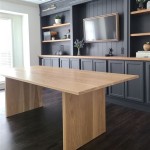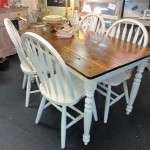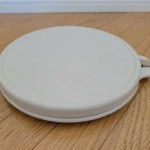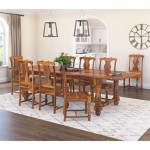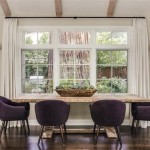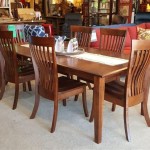The Enduring Appeal of a White-Washed Dining Room Table
The dining room table often serves as the heart of a home, a central gathering point for meals, conversations, and shared experiences. The aesthetic of this crucial piece of furniture profoundly influences the overall ambiance of the dining space. A white-washed dining room table, in particular, has gained significant popularity in recent years due to its versatility, timelessness, and ability to brighten and modernize any dining room. This article will explore the characteristics, benefits, and considerations associated with choosing a white-washed dining room table.
The term "white-washed" generally refers to a finishing technique applied to wood furniture. It imparts a light, airy, and often rustic appearance. The process usually involves applying a diluted white paint or stain to the wood surface, allowing the natural grain and texture to remain visible. This distinguishes it from a solid white painted finish, which completely conceals the wood beneath. The level of white wash can vary, ranging from a subtle, translucent effect where the wood grain is highly prominent to a more opaque finish where the white color is more dominant. This adaptability makes it suitable for diverse design styles and personal preferences.
Versatility and Adaptability Across Design Styles
One of the most compelling reasons to opt for a white-washed dining room table is its exceptional versatility. It seamlessly integrates into a wide spectrum of interior design styles, from classic farmhouse to contemporary minimalist. In a farmhouse setting, a white-washed table with rustic features, such as visible knots and distressed edges, can enhance the cozy, inviting atmosphere. Paired with mismatched chairs and vintage accessories, it evokes a sense of history and warmth.
In contrast, a white-washed table with a cleaner, more streamlined design can complement a modern or Scandinavian-inspired dining room. Its light color and understated elegance create a sense of spaciousness and airiness, which are hallmarks of these design aesthetics. When combined with sleek chairs in neutral tones and minimalist decor, it provides a sophisticated and uncluttered look. The adaptability also extends to transitional styles, blending traditional elements with contemporary accents. Choosing the right level of white wash and the appropriate shape and leg design can help the table seamlessly blend into this varied style.
Beyond the broad design styles, a white-washed table can also be tailored to reflect individual preferences. The choice of wood species, the texture of the finish, and the hardware selected for any extensions or drop leaves can all contribute to a unique and personalized piece. The flexibility inherent in the white-washed finish allows it to be incorporated into virtually any existing decor, making it a safe and stylish choice for homeowners unsure of long-term trends.
Furthermore, the neutral coloration of the white-washed finish makes it an ideal backdrop for showcasing colorful tableware, linens, and centerpieces. It does not clash with other colors or patterns, allowing for greater freedom in decorating and setting the table. This makes it a practical choice for those who frequently change their dining room décor or enjoy experimenting with different tablescapes.
Creating a Bright and Inviting Atmosphere
The lightness of a white-washed dining room table contributes significantly to the overall brightness and ambiance of the dining space. White, in general, is known for its reflective qualities, bouncing light around the room and creating a sense of openness. This is particularly beneficial in dining rooms that receive limited natural light or are located in darker areas of the home. A white-washed table can visually expand the space and make it feel more welcoming and airy.
In addition to reflecting light, white also has a psychologically uplifting effect. It is often associated with cleanliness, purity, and serenity, creating a calming and relaxing environment. This can be particularly desirable in a dining room, where the intention is to foster comfortable and enjoyable meals. The presence of a white-washed table can subtly contribute to a more positive and harmonious atmosphere.
The brightness and neutrality of a white-washed table also help to highlight other design elements in the room. It serves as a visual anchor without overpowering the space, allowing artwork, textiles, and accessories to stand out. This makes it a versatile choice for showcasing personal style and creating a unique and personalized dining environment. The ability of the white-washed table to act as a backdrop rather than a focal point allows other elements within the dining room to be more easily mixed and matched.
Consider the interplay between light and color when choosing a white-washed table. The tone of the white can vary slightly, ranging from a cool, crisp white to a warmer, creamier white. The specific tone should be selected to complement the existing wall color, flooring, and lighting conditions in the dining room. A cooler white might be more suitable for a modern space with cool-toned walls, while a warmer white might be preferable in a more traditional or farmhouse-style setting. The subtle nuances in the white wash can significantly impact the overall feel of the room.
Furthermore, the contrast between the white wash and the underlying wood grain can add visual interest and depth to the table. The visibility of the wood grain provides a natural and organic element that softens the crispness of the white finish. This combination of clean lines and natural texture creates a balanced and visually appealing aesthetic.
Durability, Maintenance, and Practical Considerations
While aesthetics are important, durability and ease of maintenance are also crucial factors to consider when selecting a dining room table. A white-washed finish, while beautiful, requires careful consideration to ensure its longevity. The type of wood used and the specific finishing process employed play a significant role in the table's overall durability and resistance to wear and tear.
Hardwoods, such as oak, maple, and birch, are generally more durable and resistant to scratches and dents than softwoods like pine. When selecting a white-washed table, it is advisable to choose one made from a hardwood, particularly if the table will be used frequently. The density and inherent strength of hardwood will help it withstand daily use and maintain its appearance over time. Softwoods, although more affordable, may show wear and tear more quickly and require more frequent refinishing.
The finishing process also impacts the table's durability. A high-quality sealant or topcoat is essential to protect the white-washed finish from stains, spills, and scratches. A durable topcoat will create a barrier between the wood and potential damage, making it easier to clean and maintain the table. Consider the type of sealant used and inquire about its resistance to water, heat, and common household chemicals. A polyurethane or lacquer finish is often a good choice for its durability and ease of cleaning.
Maintenance of a white-washed dining room table typically involves regular cleaning with a soft, damp cloth to remove dust and debris. Avoid using harsh chemicals or abrasive cleaners, as these can damage the finish. For spills, wipe them up immediately to prevent staining. Consider using placemats and coasters to protect the table surface from heat and moisture. These simple precautions can help prolong the life and beauty of the table.
The visibility of the wood grain, a key characteristic of the white-washed finish, can also influence maintenance. If the wood grain is heavily textured, it may be more difficult to clean food particles and spills from the crevices. Consider the texture of the finish and choose one that is relatively smooth and easy to wipe clean. A smoother finish will also reduce the likelihood of snagging tablecloths or clothing.
Finally, consider the overall construction and stability of the table. A well-built table will be sturdy and resistant to wobbling or tipping. Inspect the legs and joints to ensure they are securely fastened. A solid construction will not only enhance the table's durability but also ensure the safety and comfort of those using it. A wobbly table can be frustrating and potentially dangerous. It's also worth considering investing in furniture pads or glides for the legs to protect flooring from scratches and make it easier to move the table when necessary.

Whitewashed Reclaimed Wood Dining Table

How To White Wash A Table In Under 30 Minutes Shabbyfufu Com

Whitewashed Dining Table With Wicker Chairs Cottage Room

Buy Round Dining Table And Four Chairs Limed Washed Pine Online In Etsy

Buy Serengeti Solid Wood 6 Seater Dining Set In Whitewash Finish At 10 Off By Woodsworth From Pepperfry

How To White Wash A Table In Under 30 Minutes Shabbyfufu Com

Whitewash Wood Table An Heirloom Makeover Do Dodson Designs

Whitewash Dining Table 6 Wood Rattan Chairs Set

Marble Top Solid Wood 4 Seater Dining Set With Whitewash Finish At Rs 49999 In Roorkee

Ink Ivy Sonoma 72 Wide Reclaimed White Wash Dining Table 186x1 Lamps Plus

